ZACK BADDORF
The first thing I saw when I entered Shyrokyne was a car, shot up and smashed. A dead dog lay next to the wreckage.
It was indicative of at least one thing — the war never ended here.
In February, Ukraine and pro-Russian separatists signed a piece of paper called a “ceasefire agreement.” But that hasn’t stopped the daily fighting for control of Shyrokyne, a small town in the country’s east.
Street fighting and artillery bombardment decimated the city. During a recent visit with the Organization for Security and Cooperation in Europe, I heard the sharp crack of nearby machine gun fire throughout the day.
Artillery shelling happens at night — after the observers leave.
There’s no running water or electricity. Medical care is limited. Obtaining basic supplies is dangerous. I saw rocket-propelled grenade launchers inside an abandoned playroom for kids. The room is now a forward operating base on the front lines of the conflict.
Most people have fled. About 30 Ukrainians remain in this hotly contested area, located only a brief drive away from the Ukrainian-held port city of Mariupol.
Overlooking Shyrokyne from some high ground in the town of Berdyans’ke, a 26-year-old Ukrainian military officer said both the Russian-backed Donetsk People’s Republic and Russia want to capture Mariupol in order to “make a bridge to Crimea.”
Russia invaded and annexed Crimea last year.
“If all society does not stop Putin, it will be a third world war,”
the Ukrainian officer, whose nom de guerre is “Kirt,” said.
Kirt comes from the Ukrainian capital of Kiev, and is a member of the controversial all-volunteer Azov Battalion — known for its military discipline and ties to far-right groups.
“We protect Ukrainian territory from the aggression of Russian and separatist forces,” Kirt said. “Now we prepare much more than in September but it would still be very hard to fight against the Russian military.”
“We have enough supplies to do our duty but not enough to fight the Russian military,” he added.
He told us his troops fight with old equipment. “We’re always repairing, repairing, repairing,” he said. “It’s like I’m fighting with the AK my grandfather fought with.”
 Another Azov Battalion soldier, “Fox,” said he feels like he’s in his “place” on the front lines. “I’m honored to be here. The poor conditions don’t matter. I don’t feel bad about it. It’s part of your job, part of your life,” he explained.
Another Azov Battalion soldier, “Fox,” said he feels like he’s in his “place” on the front lines. “I’m honored to be here. The poor conditions don’t matter. I don’t feel bad about it. It’s part of your job, part of your life,” he explained.
Kirt said the rebels regularly fire 120-millimeter artillery on the Ukrainian positions, violating the ceasefire. He said half the time the separatists hit military targets, and half the time they hit civilian areas.
The Azov Battalion, he said, isn’t breaking the Minsk ceasefire conditions.
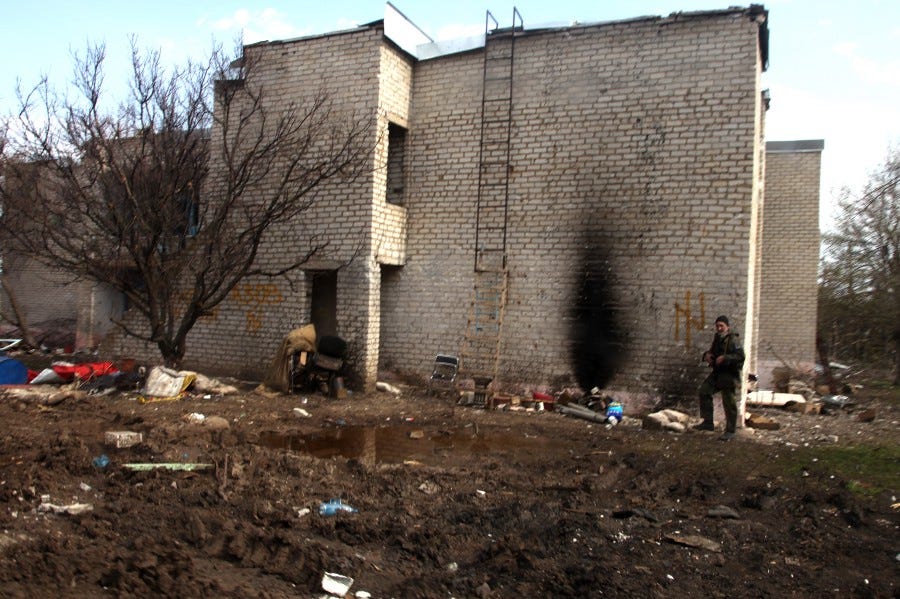 Kirt is certain that he and about 150 soldiers in his command are fighting against both pro-Russian Ukrainian separatists and Russian military officers.
Kirt is certain that he and about 150 soldiers in his command are fighting against both pro-Russian Ukrainian separatists and Russian military officers.
“It’s a style of war and sometimes we can hear [the Russians] on the radio,” he said.
Another Azov Battalion soldier concurred. “You can tell when we’re fighting with the Russians. They fight very well,” Ivan Kharkiv, the battalion’s spokesperson, said.
“When it’s just the separatists, they fight poorly. They’re scared.”
“We have reported that we have seen uniformed men wearing the insignia of the Russian Federation,” Alexander Hug, the deputy chief monitor of the OSCE’s mission in Ukraine, said at a press conference held in Shyrokyne.
“But to draw a conclusion that these uniformed carriers are actually servicemen from another country is not for me to conclude.”
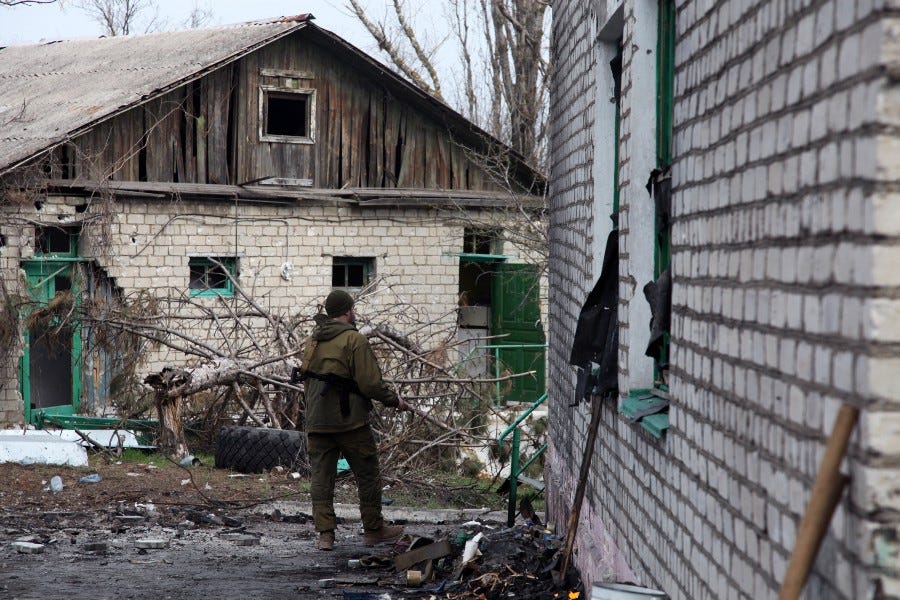 Kharkiv — who claims to have seen a Russian tank on the battlefield — said a full-on fight with the Russian army would be bloody on both sides.
Kharkiv — who claims to have seen a Russian tank on the battlefield — said a full-on fight with the Russian army would be bloody on both sides.
“We don’t have a lot of equipment but we can still fight well against [the Russians],” said the 20-year-old soldier. “It will be a huge, huge war — a real war.”
“Fox,” an Azov Battalion fighter from central Ukraine, said he’s seen Russian soldiers but wouldn’t provide details due to operational security. He did say he’s heard them speaking and recognized their Russian accents. Fox has spent time in Moscow.
A tank with a Russian flag on its antenna had fired at Fox before. The round punched through the walls one floor below where I interviewed him. Fox wasn’t wounded but he was “really, really shaken up” and was deaf for a month.
Fox said his job now is to stop the separatists from advancing on Mariupol.
“Russia wants to take everything,” he said. “Our job is to not allow them to take anything.”
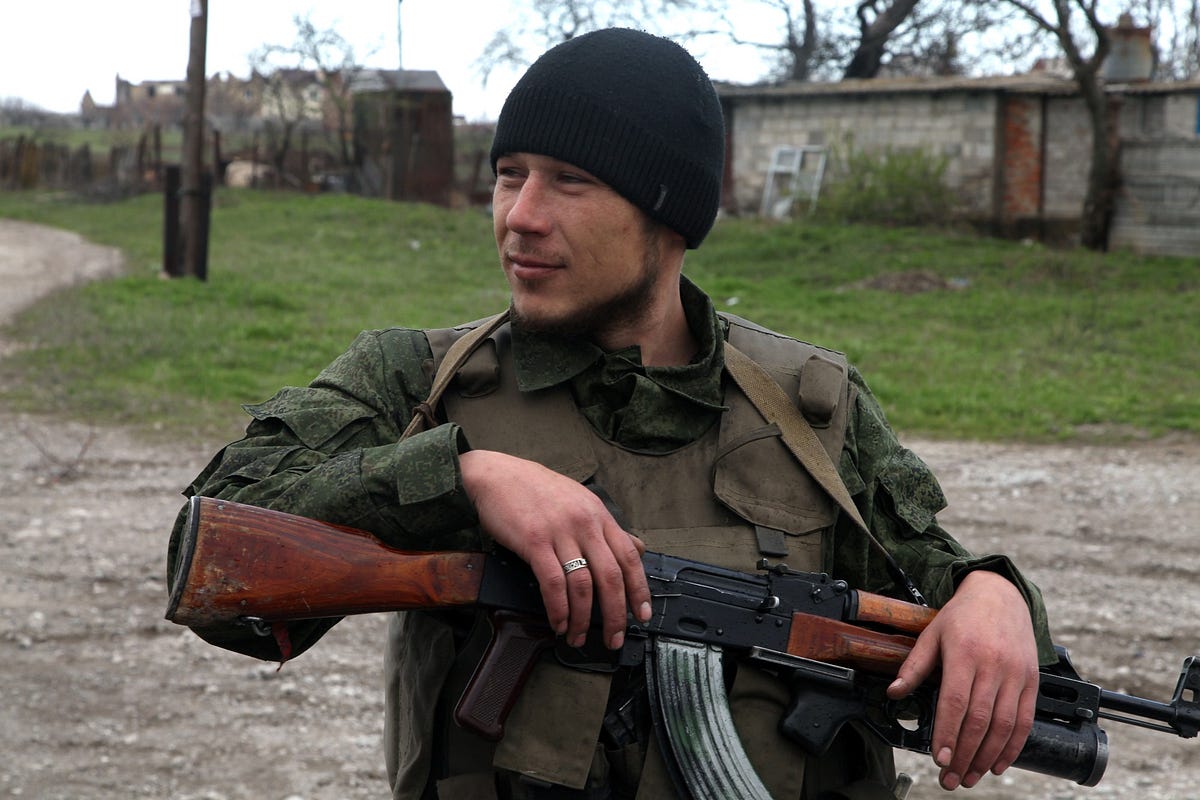 Across the front lines and inside territory controlled by the DPR, separatist commander “Sergei” denied that Russia is supporting his troops.
Across the front lines and inside territory controlled by the DPR, separatist commander “Sergei” denied that Russia is supporting his troops.
“Personally, I don’t meet with people who provide things from Russia,” the 50-year-old commander told me inside the dining room of a dacha summer home on the outskirts of Donetsk, which serves as a base for about a dozen separatist troops.
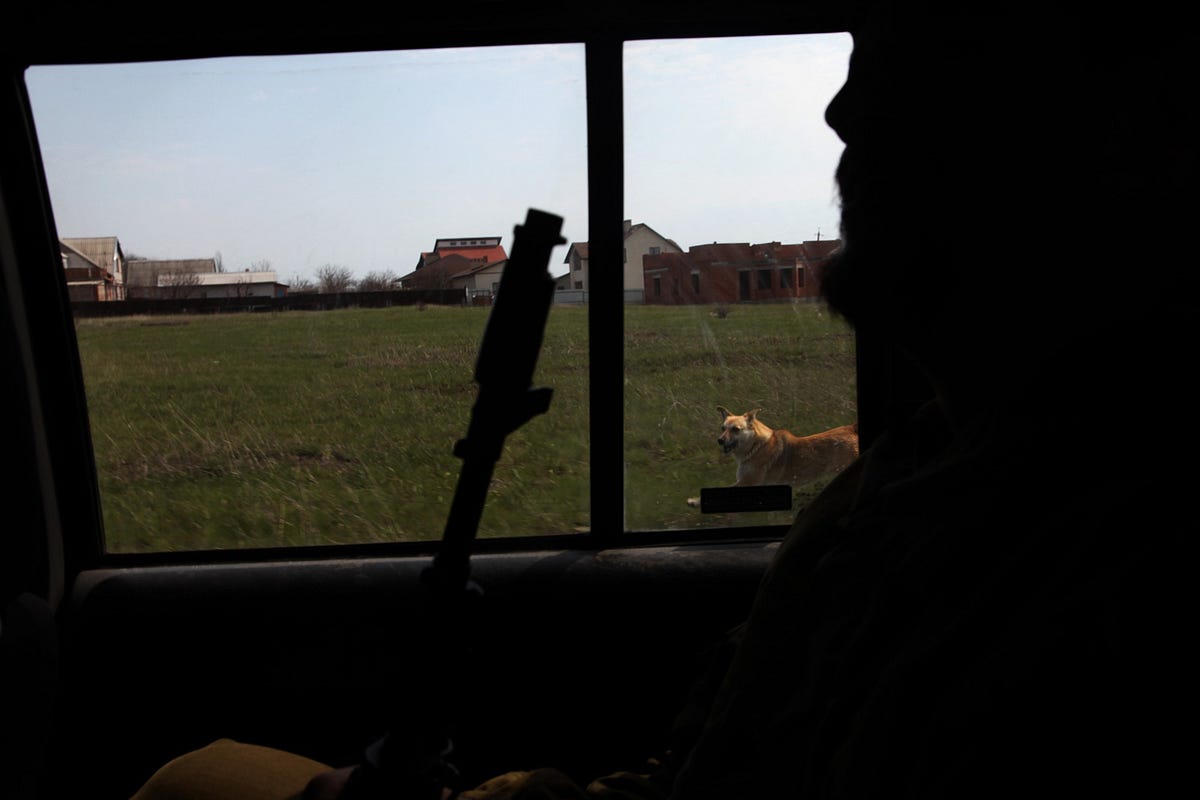 “All the weapons we have are taken from Ukrainians in battle,” he said, while displaying an AK and camouflaged set of webbing to hold gear.
“All the weapons we have are taken from Ukrainians in battle,” he said, while displaying an AK and camouflaged set of webbing to hold gear.
“All the uniforms are bought by us individually,” he added. While some Russians have donated clothes and boots, the DNR supplies ammo and weapons for his soldiers.
“In the beginning, it was very slow and difficult and there wasn’t enough ammo,” Sergei said. “First I took a rifle and four magazines and was wearing a sports suit. I went to attack and took guns and ammo from [dead] Ukrainian soldiers.”
Yet Sergei, who is from the eastern Ukrainian town of Makiivka, reminisces about the country’s Soviet past. “When Ukraine was in the USSR in the 1950s and 1960s, industry was growing,” he said. “Society was blossoming. The population was increasing. I want the same thing now.”
“Maybe, I want to be part of Russia,” the separatist militant said.
“It’ll be better for us. Because it’s better than being part of Ukraine.”
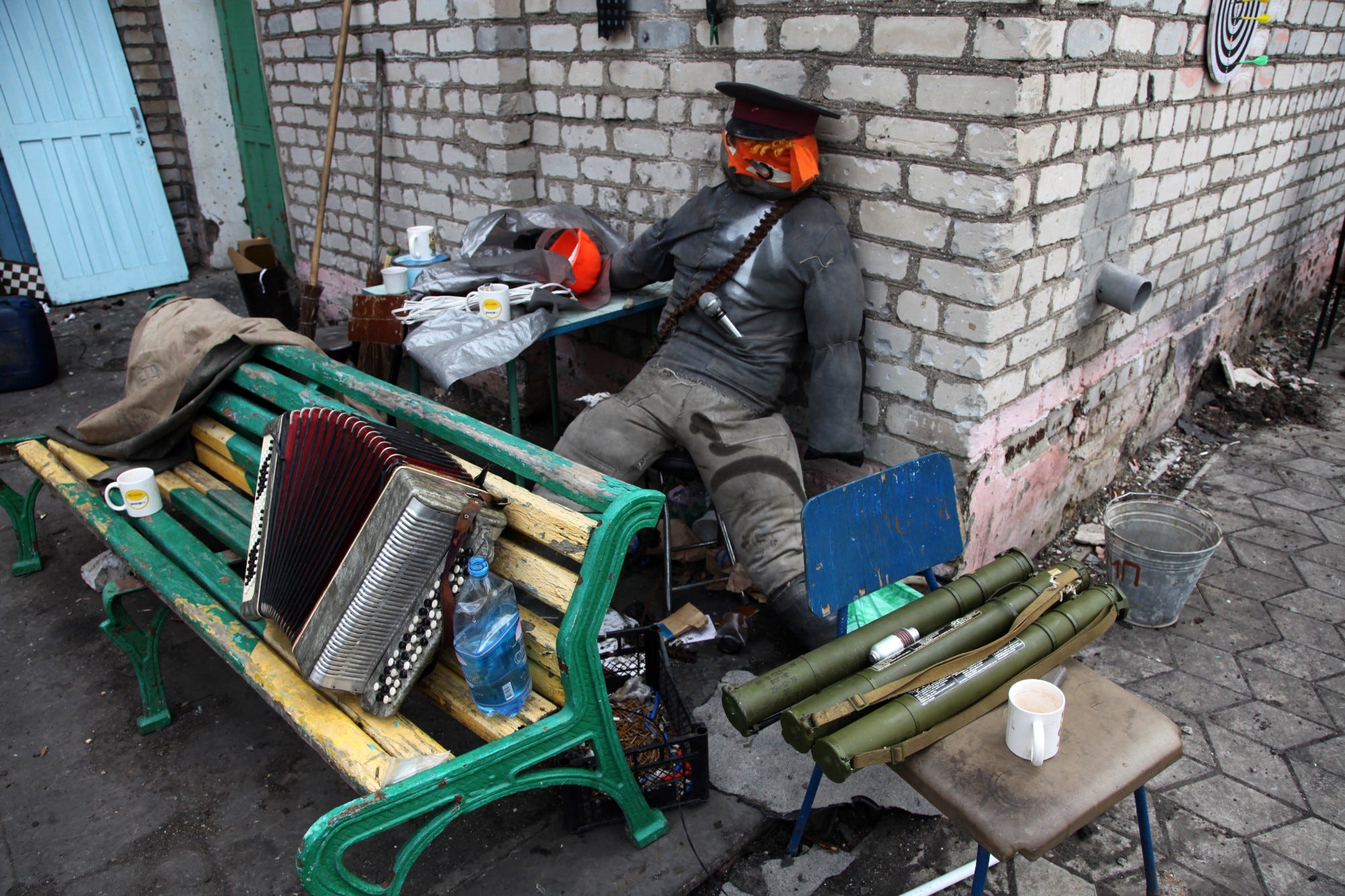 Inside this makeshift barracks, the rebels prominently posted a picture of Russian Pres. Vladimir Putin next to a map of Donetsk — the political headquarters of the self-proclaimed Donetsk People’s Republic. Sergei said Russians are welcome to come join the fight.
Inside this makeshift barracks, the rebels prominently posted a picture of Russian Pres. Vladimir Putin next to a map of Donetsk — the political headquarters of the self-proclaimed Donetsk People’s Republic. Sergei said Russians are welcome to come join the fight.
“If the Russian regular army was here, the war would already be over,” Sergei said.
One of Sergei’s soldiers is a Russian national who came to Ukraine to fight for the DPR.
“I wanted to protect people because [the Ukrainians] are killing children,” said the Russian fighter named “Stranic,” while gingerly holding an AK-47 in his lap.
No one asked him to fight, he explained. He became motivated after watching Russian television and YouTube videos about the conflict.
“I came with no weapons, no training,” Stranic said. His nickname means “stranger” in Russian. “Here, I’m getting some training everyday and learning [military] tactics.”
Twenty-eight year-old Stranic is a former construction worker and has a family back home waiting for him in Taganrog, Russia.
“I’m very scared for my daughter and wife. I’m worried what would happen if the Ukrainian military broke through our [Russian] defenses,” Stranic said.
I asked him if he feels connected to the people in Donetsk and Lugansk. “We’re the same people,” he said, adding that he used to visit Donetsk in his childhood. “I’m not here for politics but to defend the children and the people here.”
“We didn’t start this war. We sat quietly last year when people with arms [the Ukrainian military] came. They wanted to take my home and land. And then I realized there’s no exit from this situation. Only then did I take up a rifle to defend myself,” he added.
“As a guest you may come here. But if you have a rifle, you will die here.”
“Slavian,” another soldier under Sergei’s command, wanted to fight the new pro-Western government in Kiev.
“Ukraine is ill with fascism and Nazism. They are all nationalists and fascists. It’s impossible for [ethnic] Russians to live here with them as part of Ukraine,” the 51-year-old man said.
The mayor of a DPR-held town echoed the same rhetoric.
“We stood up and made a republic because the West [of Ukraine] is always with NATO and we see fascism, Nazism, and violence there. We don’t want this. It’s not our ideology,” Novy Svet mayor Dmitry Baranov said. “We want to break this social mold. We won’t live like that here.”
Baranov is “very angry” about the Ukrainian government in Kiev.
“After a year, they’ve done nothing — only war. For the people, for the country — nothing, only war. Prices are rising. Gas is going up. Social security payments are down. Taxes just go to pay for the war,” Baranov said.
The mayor told me the rebels will not be defeated easily.
“We will stand for our republic, for our nation, for our kids, our mothers, our women, until our last drop of blood. We won’t take any steps back. We’ll stand here and die, if necessary.”
Baranov had a message for Ukrainian soldiers — “If you want to live, you better leave now.”
 The separatists’ accusations of fascists fighting on the Ukrainian side isn’t entirely unfounded. The Azov Battalion is a far-right organization. Its politics are national socialist.
The separatists’ accusations of fascists fighting on the Ukrainian side isn’t entirely unfounded. The Azov Battalion is a far-right organization. Its politics are national socialist.
Not every Azov fighter is a Nazi — and most Ukrainian soldiers are certainly not. Far from it. But Kiev has to fight this battle largely alone, and the fledgling government can’t afford to be choosy about who fights for it.
Even if some of its fighters belong to far right groups such as Azov.
But Kharkiv disputed the allegations that he and his fellow soldiers are extremists. “All those who aren’t Russian are fascists. That’s what they think,” Kharkiv explained to me while we were at a military base in Mariupol.
Kharkiv said the Azov Battalion soldiers are “not socialists, not communists, not neo-Nazis or fascists. We’re just guys who love Ukraine and who want to live in a united country.”
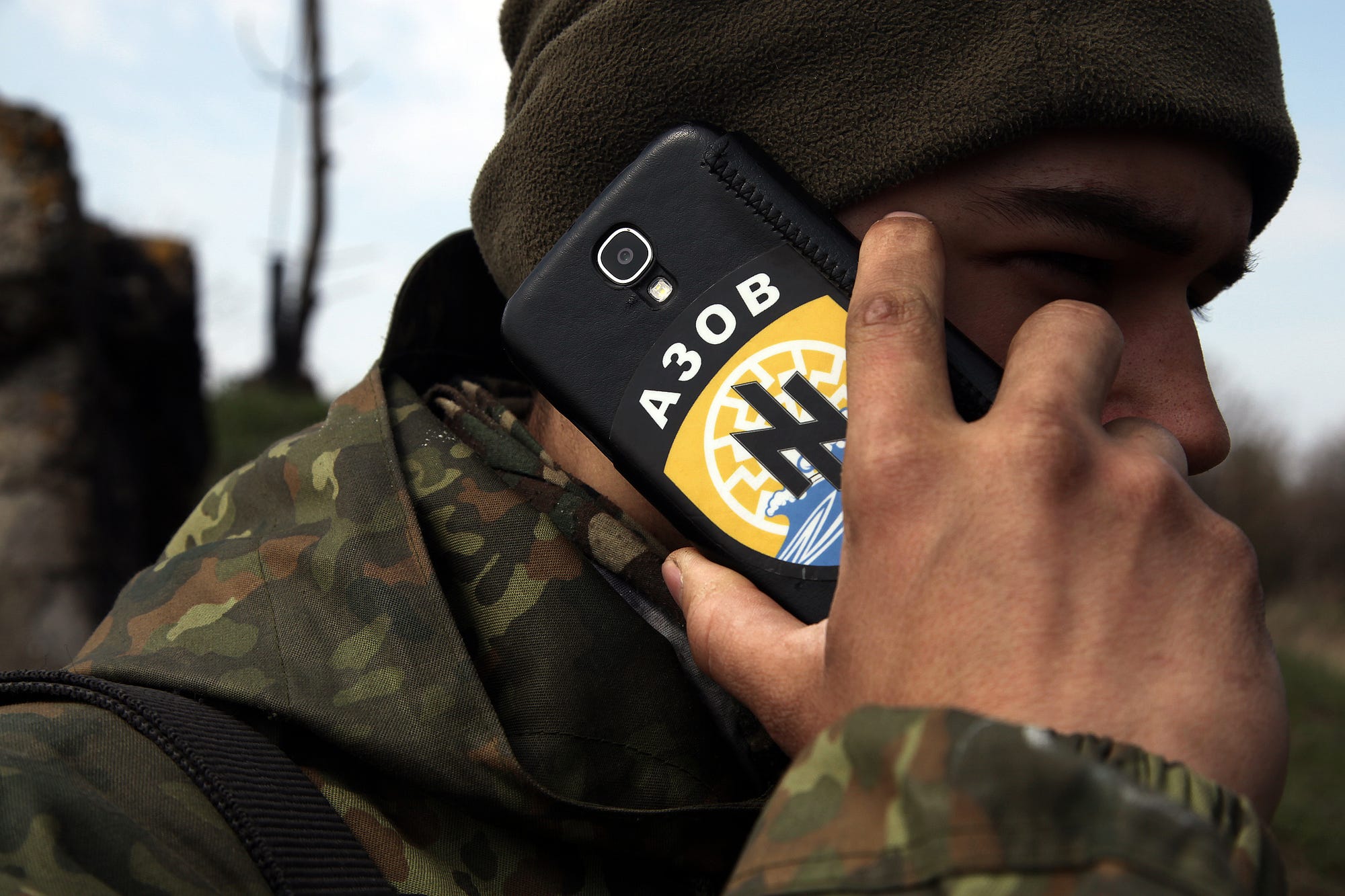 “It doesn’t make any sense to be with Ukraine,” the DPR mayor Baranov told me. “We want to be part of Russia, just like Rostov or Moscow.”
“It doesn’t make any sense to be with Ukraine,” the DPR mayor Baranov told me. “We want to be part of Russia, just like Rostov or Moscow.”
“They can go to Russia,” Kharkiv said. “If they want to live with Putin, they can go.”
The Azov Battalion logo includes a horizontal Wolfsangel and a Black Sun — both common symbols among extreme rightist organizations. But Azov claims the symbol is a combination of the letters “I” and “N” — standing for Nationalist Idea.
On the Ukrainian-held side of Shyrokyne, a 40-year-old Azov Battalion soldier from Donetsk said people like Baranov sow chaos. “They’re murderers,” the soldier said. He would only be identified by the name “Warrior.”
“Many of these [separatists] were my friends. Now they’re on the other side. They support Putin. I don’t feel friendship toward them anymore,” Warrior said. “They’re not patriots. They’re traitors.”
DPR soldiers destroyed Warrior’s family home — and the thought of that destruction grieves him. “But I believe we’ll win. We’ll take back Donetsk and Lugansk.”
Just then, we heard a whoosh nearby. It was an 82-millimeter mortar shell. We all rushed quickly inside the makeshift base, a bombed-out abandoned building.
I happened to be there on Warrior’s birthday. “How are you celebrating?” I asked. “By fighting,” he replied.
I walked carefully through the bombed-out building where Warrior was based, running past the windows where DPR snipers could possibly shoot at us.
“It’s the duty of anyone with balls to protect his country,” Fox told me on the roof. Formerly a screenplay writer, he’s now the commander of an automatic grenade launcher squad. Members of his team peered through binoculars, looking at enemy positions just a few hundred meters away.
Fox said he’s not sure what will happen next in this war.
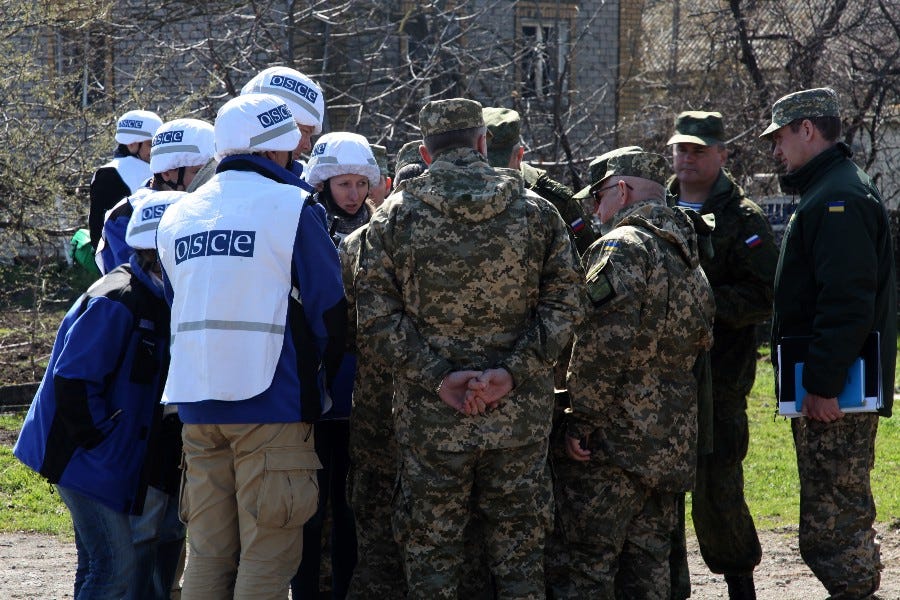 “I’m not a prophet. But if we have guys like this,” Fox said, gesturing at the soldiers around him, “our nation has real men to protect its country. We have men with balls made of steel. We’ll fight for it and stand for it.”
“I’m not a prophet. But if we have guys like this,” Fox said, gesturing at the soldiers around him, “our nation has real men to protect its country. We have men with balls made of steel. We’ll fight for it and stand for it.”
As for the ceasefire? “It’s shit. It’s empty words. It’s a lie,” mayor Baranov told me in his office. “There’s always shooting here.”
At left — OSCE observers along with a Russian general in Shyrokyne. At right — one of the few civilians I saw. Only about 30 civilians remain in Shyrokyne. Zack Baddorf photos
OSCE observer Hug said he wants the military mentality to end in this besieged town. “They should go away … but you know the two sides stand very close [enough to] actually look into each other’s eyes,” he said.
Nevertheless, the OSCE is trying to “motivate the two sides to disengage, move the military away and bring back the civilian life in town,” Hug added.
The talk of demilitarizing Shyrokyne is disconcerting to Kirt, the Ukrainian fighter. “If we go back, the Russians will shoot Mariupol like before,” he explained. “The city will be in danger.”
For now, the fighting continues in Shyrokyne despite a ceasefire that never was.

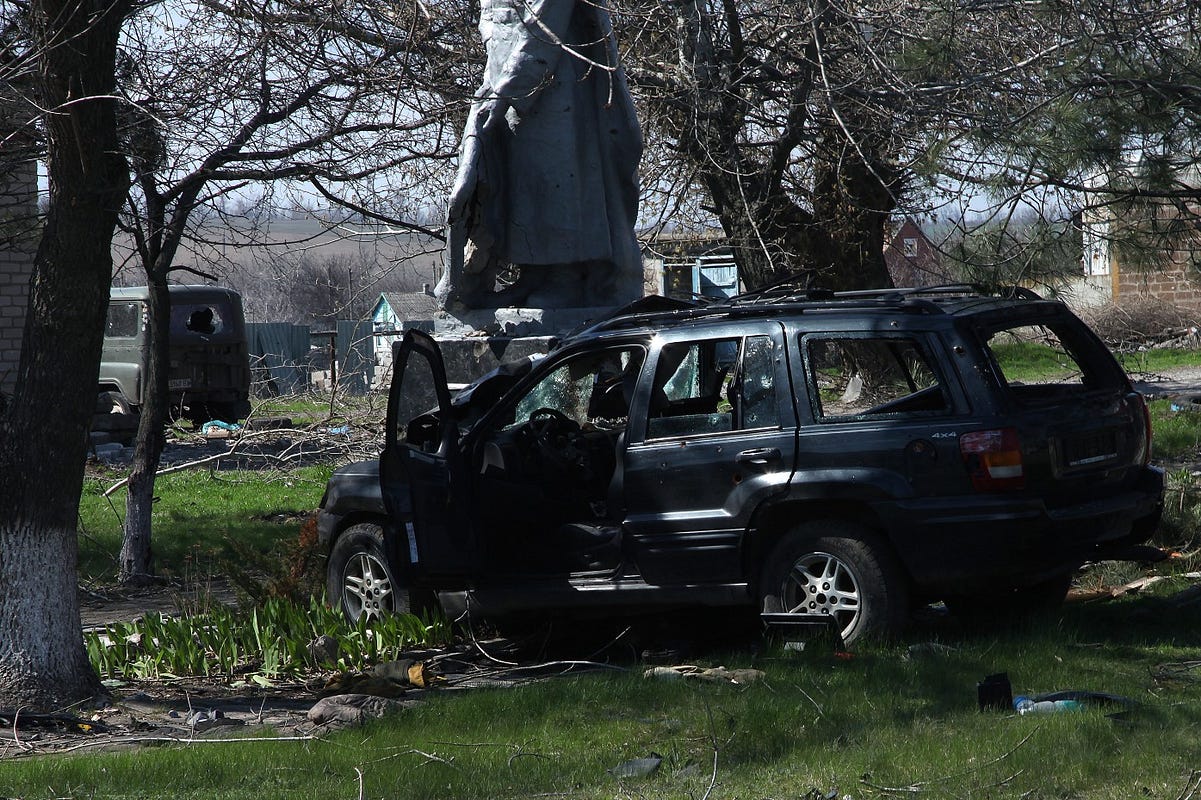
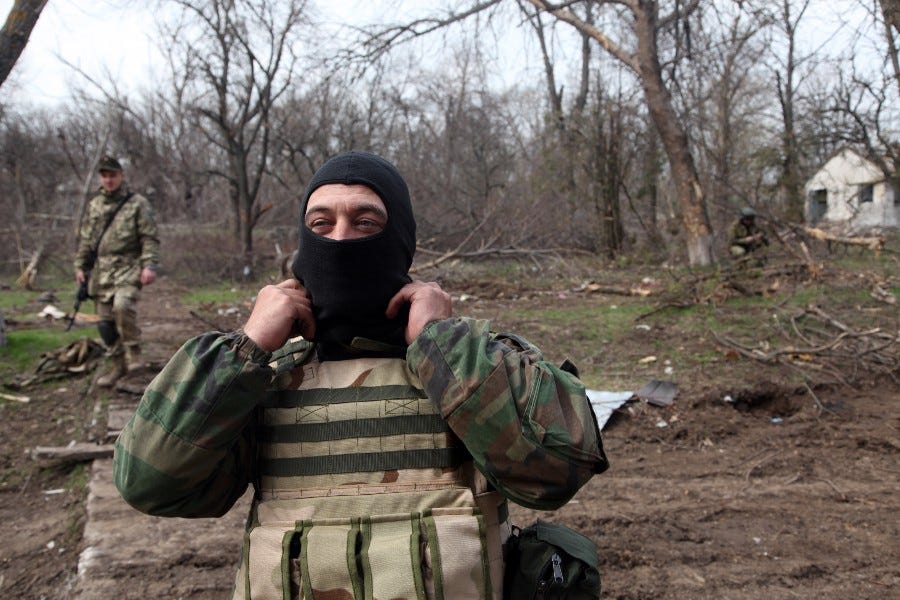
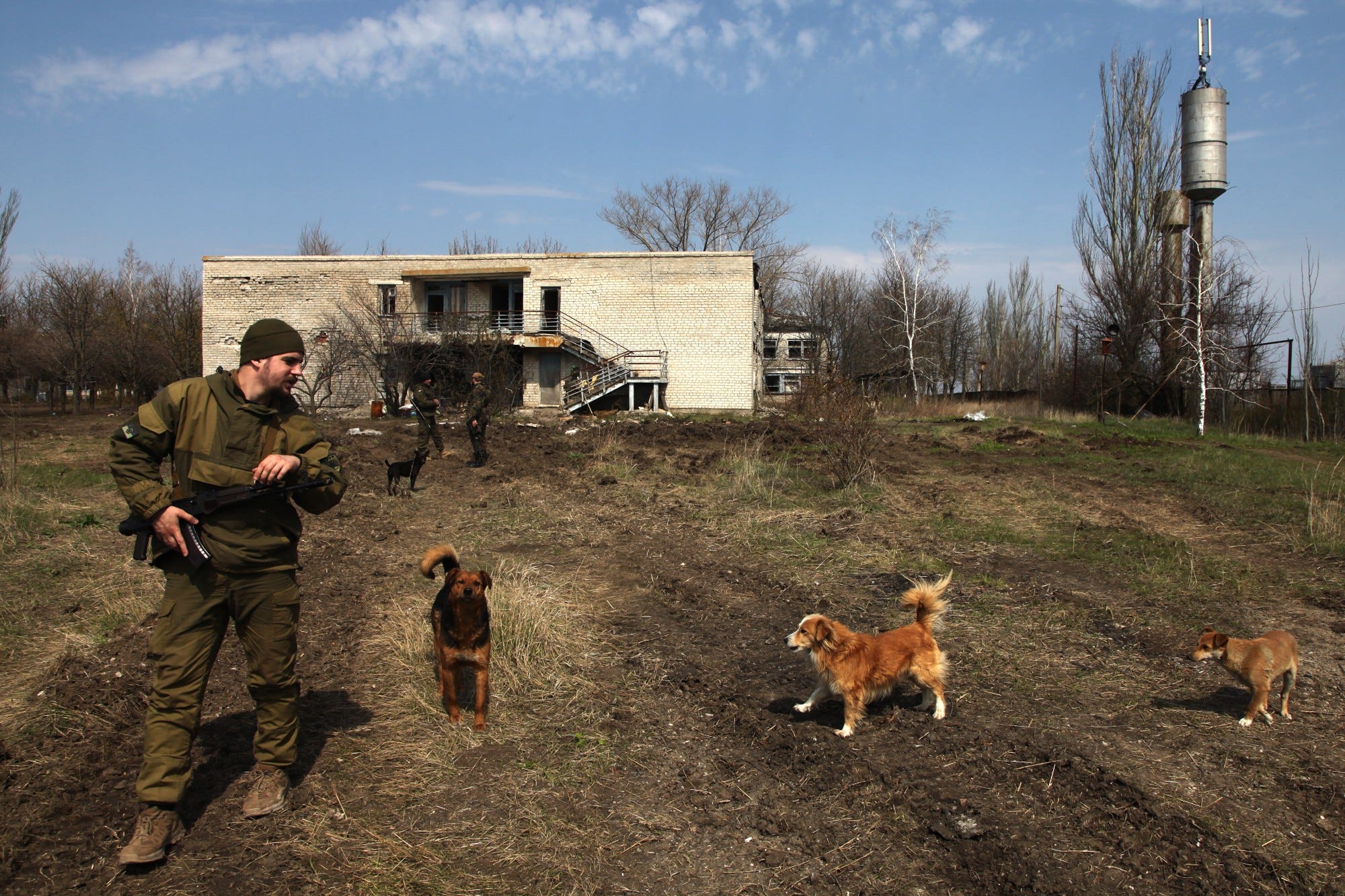
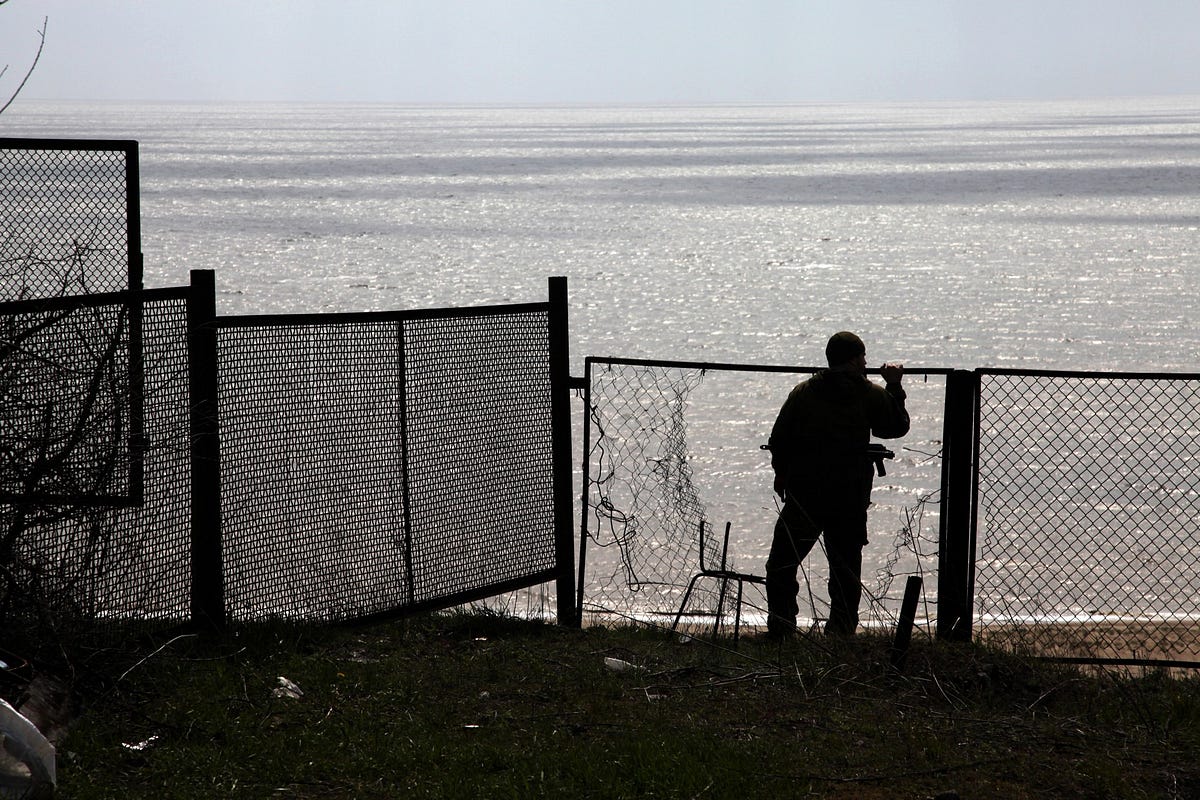
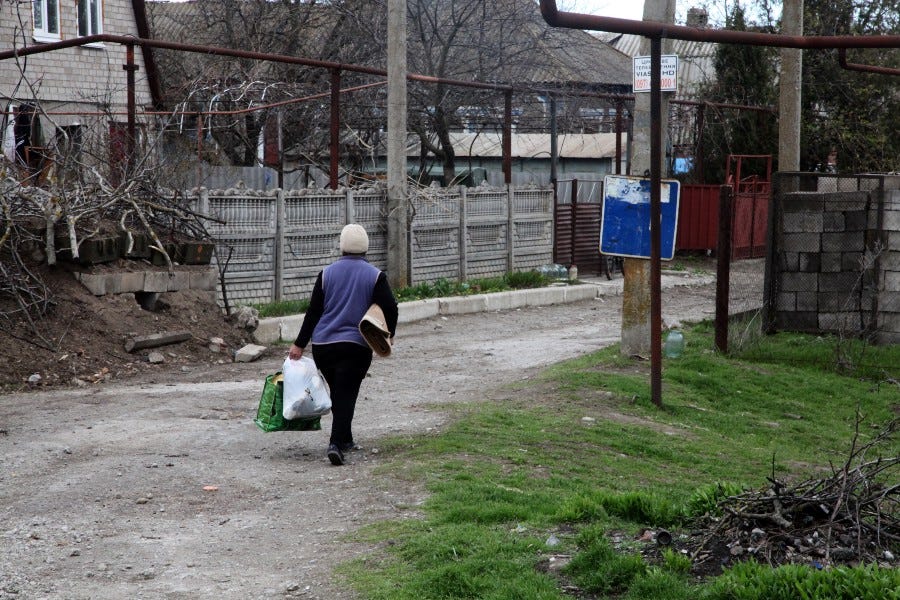
No comments:
Post a Comment